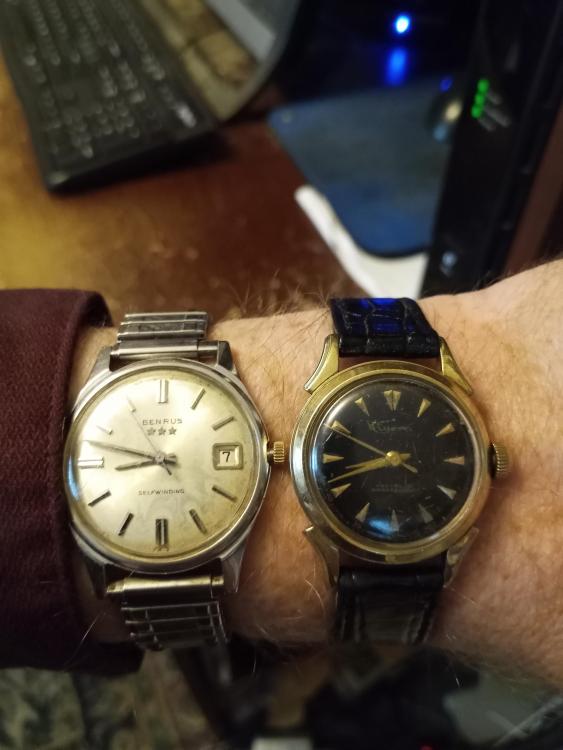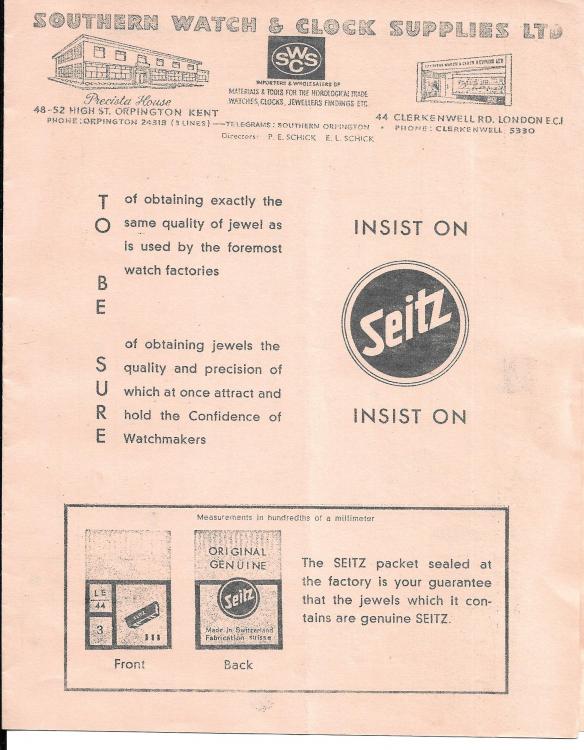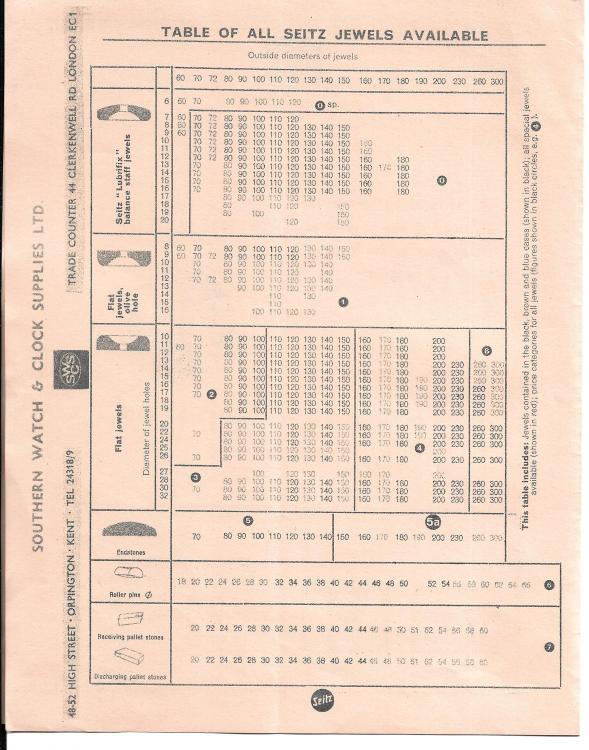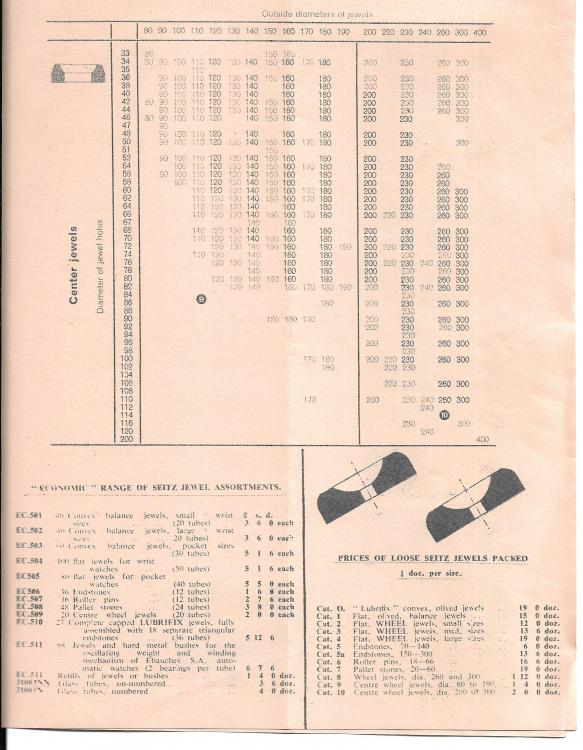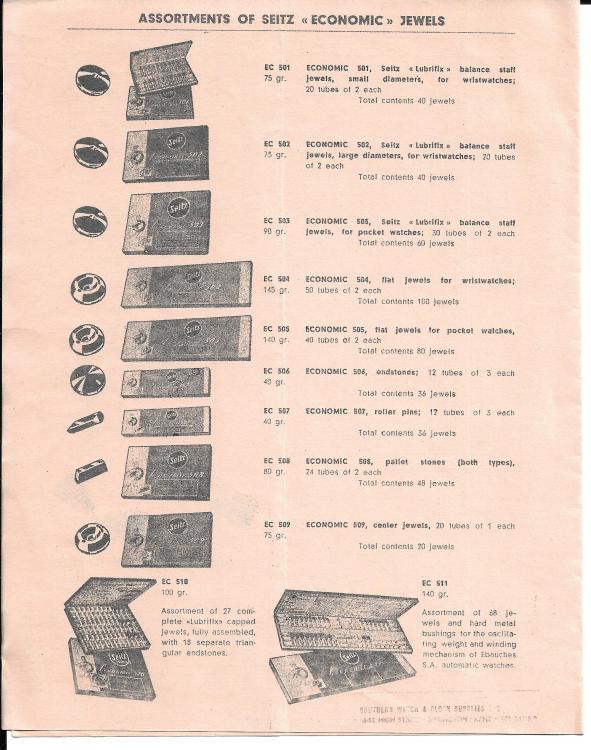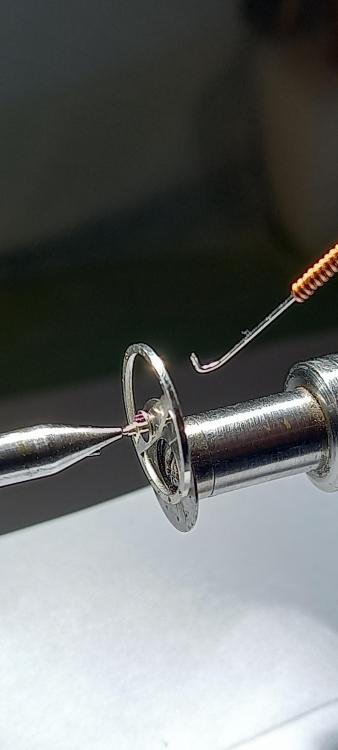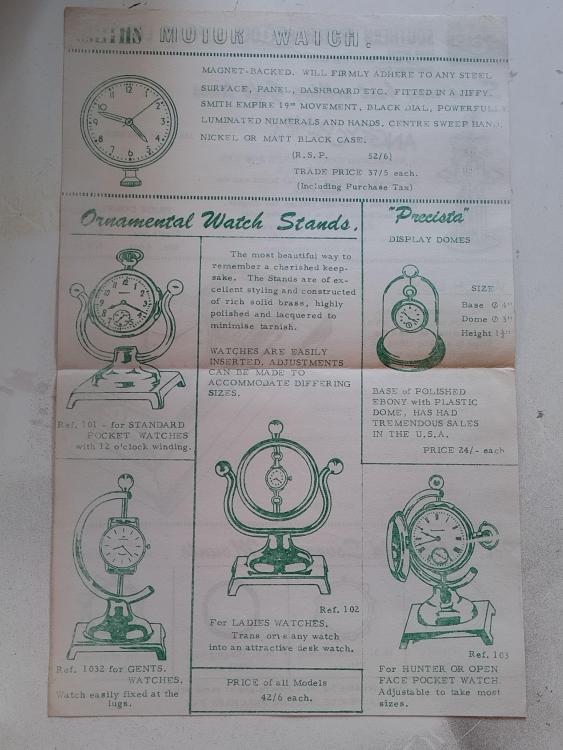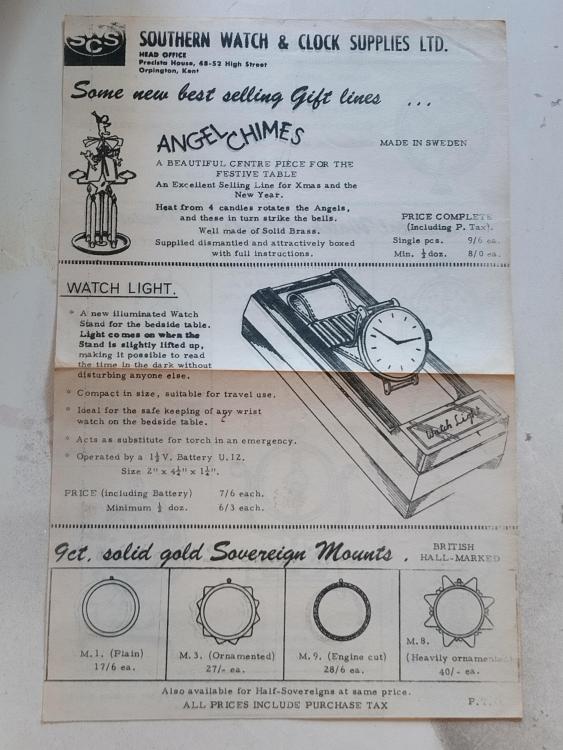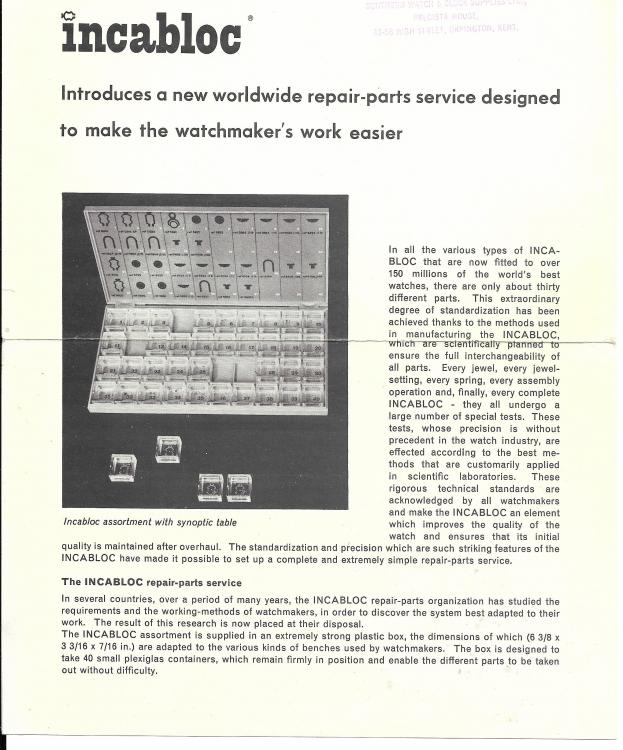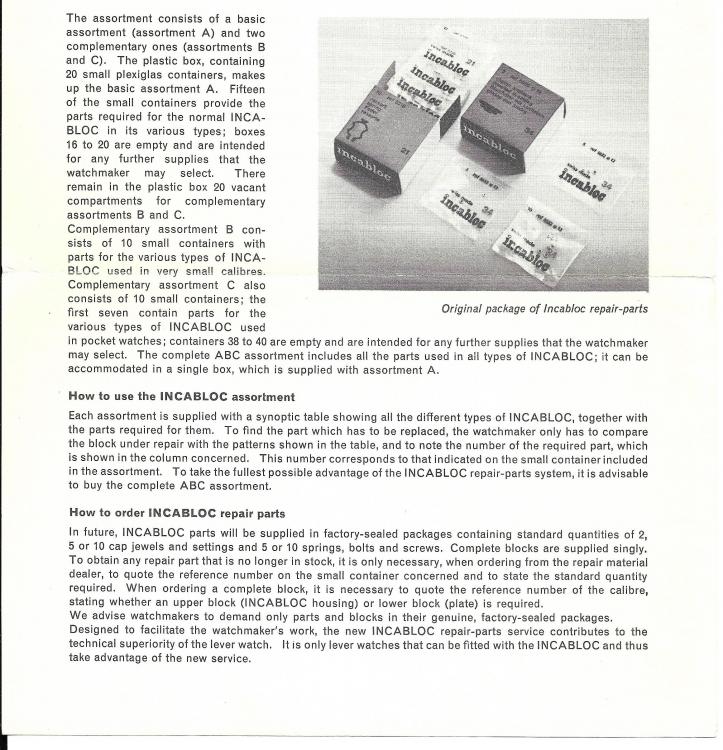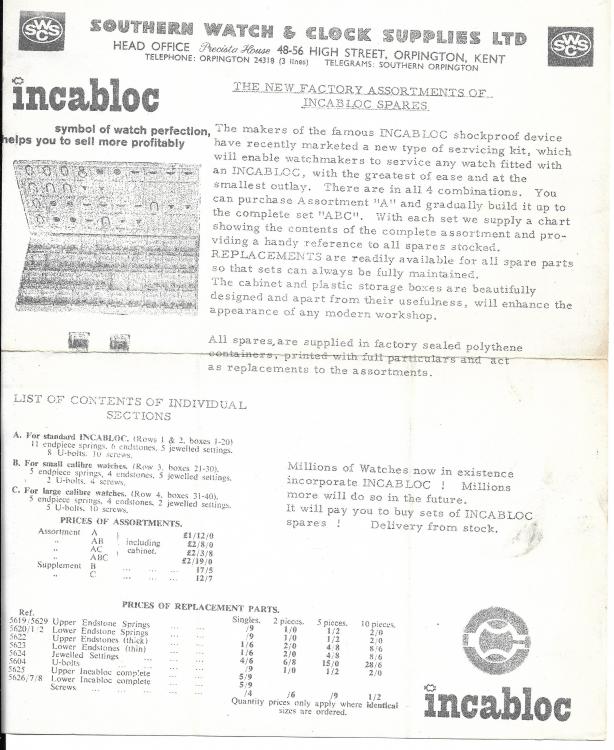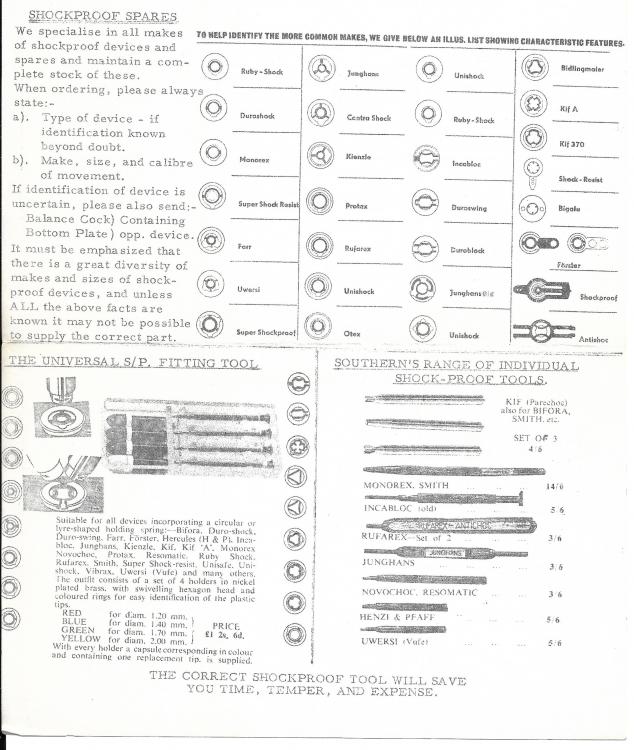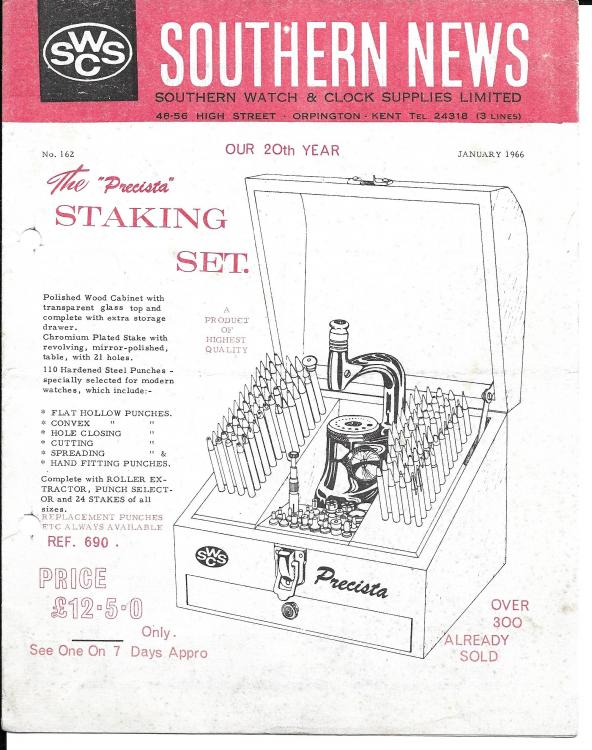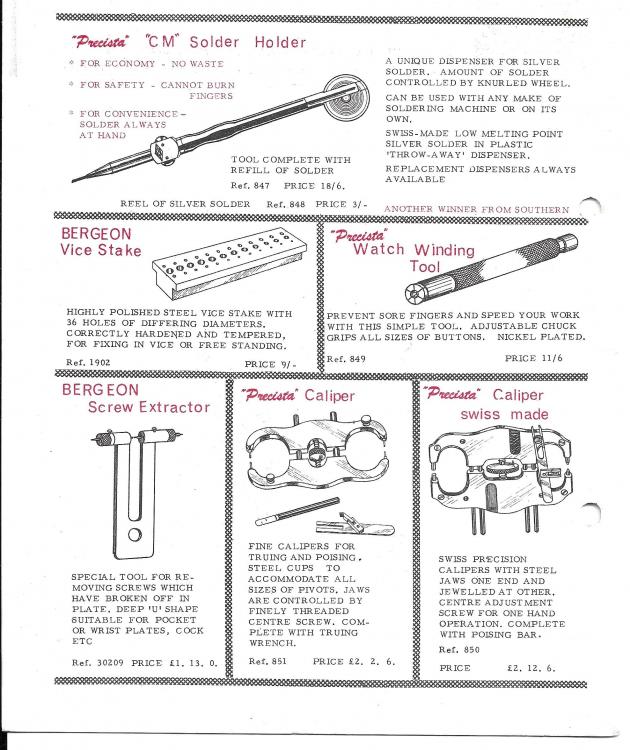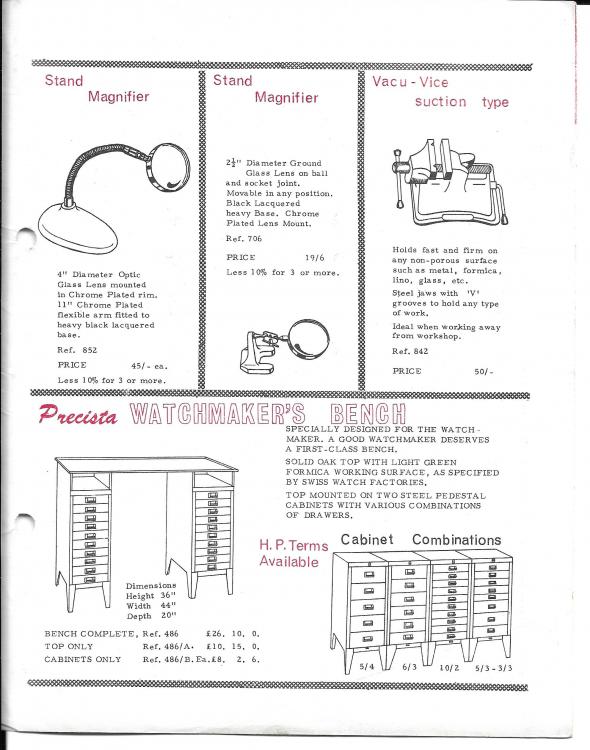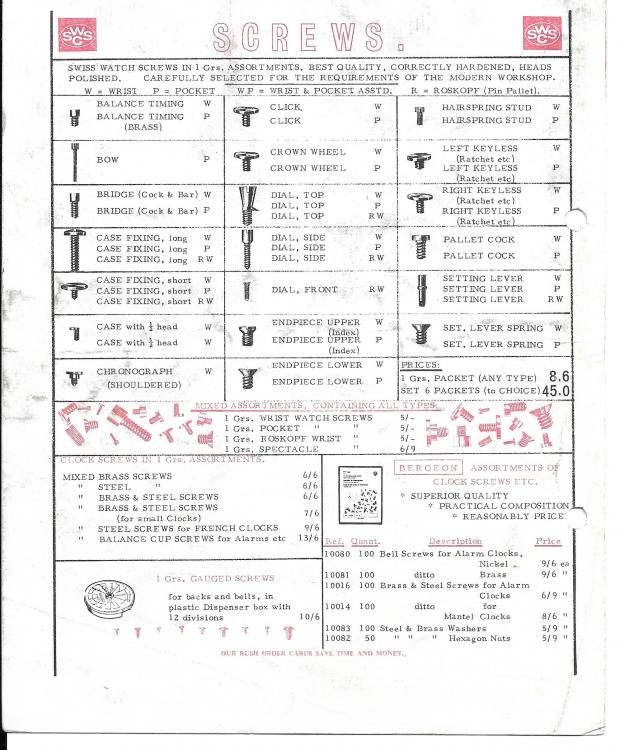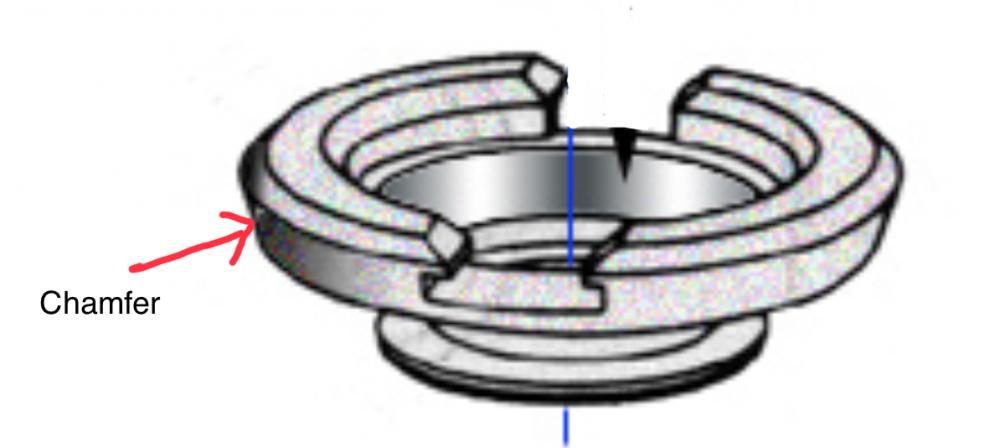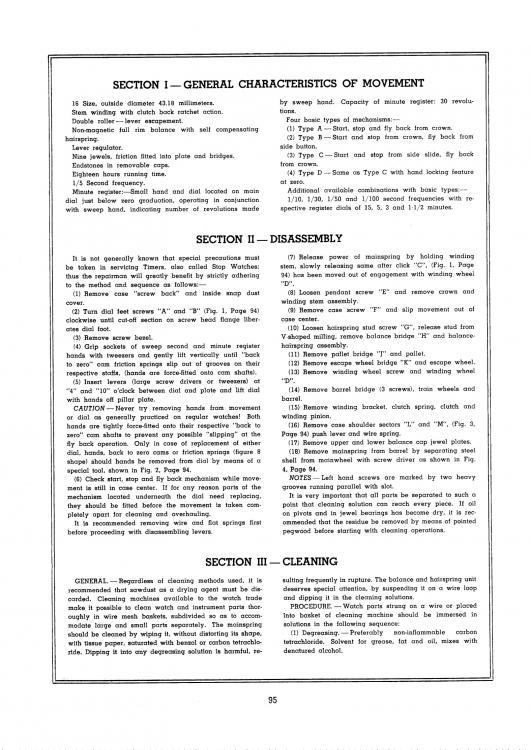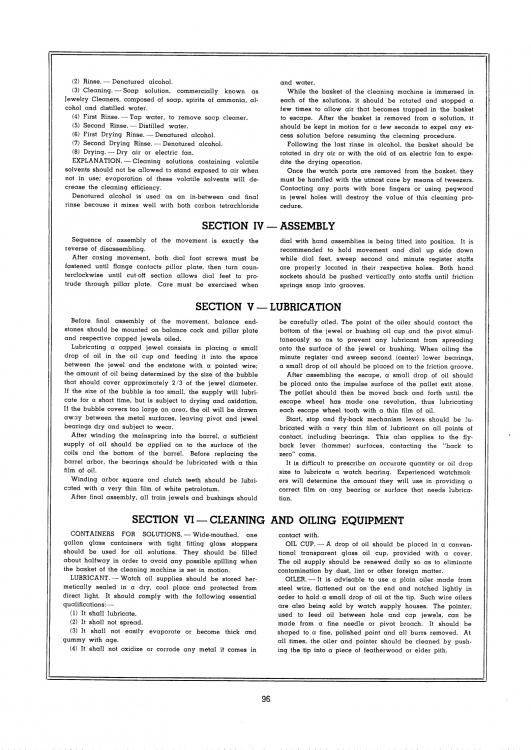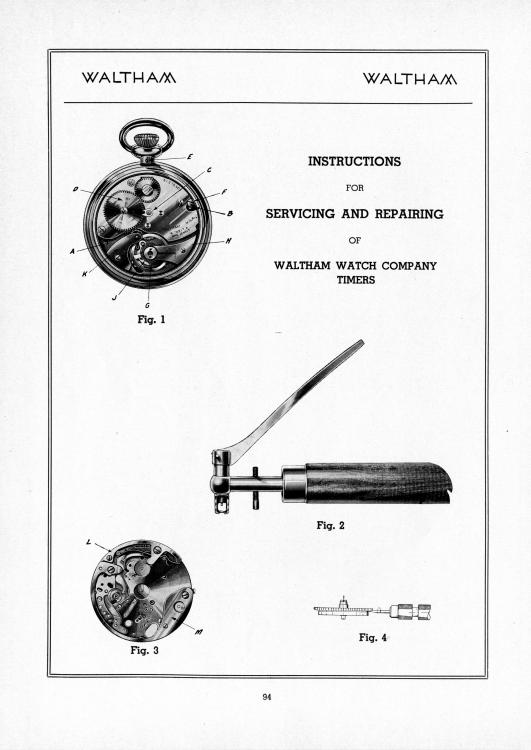Leaderboard
Popular Content
Showing content with the highest reputation on 10/07/22 in Posts
-
Had decent luck with the $1 watch bin at my local flea market. The one on the left, the Benrus 3-Star Self Winding, was presumed to be a non-runner, as it had no crown. I used a small screwdriver to test it, and it wound up and ran so I bought it. It will need a thorough cleaning as the rotor is gummed up and hardly turns. The one on the right is a Rivera by Avalon. It was presumed a non-runner, but I noticed the second hand and minute hand were locked together. At home, I uncased it and raised the second hand slightly, and it took off running immediately. The Benrus I may sell after I have serviced it. But the Rivera I may keep because I am a sucker for the color combination of black and gold.5 points
-
probably before I make a commitment to be nice to have a picture of the watch preferably over the balance wheel. But whenever I clean anything that I can't take the jewels out like pocket watch I remove the balance wheel from the balance bridge and clean it in a separate compartment so the nothings going to hit it and there's no stress on the hairspring hopefully. Sometimes I'll drop the pallet fork in the same place most the time that works sometimes the pallet fork insists on getting stuck in the hairspring I think that happened one time but typically the the pallet fork small I could go in the same container. But there is always that weird tiny possibility that it might decide to lodge itself into the hairspring usually isn't a problem but I'm just giving you a cautionary the balance wheel does best if it's all by itself.2 points
-
Welcome! I've also taken the first three levels of Mark's courses and found them worth the money. There is, however, no substitute for experience, and don't be discouraged when your first few eBay finds don't work out well. The ST36/6497 clone movement from eBay is a good place to start. You can pick one up brand new for less than $40 and not have to deal with busted-up watches and broken parts while learning how to disassemble and assemble a watch. I'm pretty sure that's the movement Mark recommends in his course, as well. And finally, ask the dumb questions. We've all been there (many of us still are, speaking for myself).2 points
-
Introduction This service walkthrough is not a tutorial on how to service a watch movement. I made it for myself because I think it's fun and because it will make it easier the next time I service a Vostok 2431. I also think it feels nice to be able to share this walkthrough considering all the valuable information that many very talented members on WRT freely share. Many, many thanks! There is a lot to learn when servicing a watch movement that is not covered in this walkthrough. Therefore, I recommend, for example, watchfix.com, learnwatchmaking.com, or timezonewatchschool.com. I feel like I got the most bang for my buck at watchfix.com (I'm not sponsored in any way) but I've also had a lot of fun and benefited from the other online schools. Links to photos on my OneDrive Vostok calibre 2431 disassembly walkthrough. Please sort the images by name in ascending order. Vostok calibre 2431 assembly walkthrough. Please sort the images by name in ascending order. Curiosities I think it was in 2014 or possibly 2015 that I bought my Sturmanskie Open Space. I had just discovered that there were watches where the hour hand only rotates one revolution per day and at that time I knew absolutely nothing about watch movements, service and repair. The idea that the hour hand of a watch only rotates one revolution per day seemed not only completely logical but also different and fascinating. The earth rotates one revolution around its axis per day, so it should be obvious that the hour hands of our watches do so too. The fact that the letters on the watch were also Cyrillic did not make the whole thing any less exciting. I just couldn’t resist it and I’m happy I didn’t! Vostok claims that their movements only need a service every 10 years, and I think that's true because the tolerances are pretty rough and therefore large amounts of dirt are needed to stop a Russian movement or even cause it to run badly. It has been said that the amount of dirt required to stop a Vostok movement is enough to stop a hundred Patek Philippe movements However, the price for this endurance is a movement that doesn't come close to the precision offered by high-quality Swiss and Japanese movements, but it's still quite easy to get these Russian movements to run accurately as long as they're worn and used consistently. About the movement Russian watch brands such as Vostok, Raketa, and Poljot, to name a few, are known for using their in-house movements, but not this Sturmanskie which is instead powered by a Vostok calibre 2431, which is a 24-hour movement. However, it is not a true 24-hour movement. That is, the movement is not originally designed as a 24-hour movement. Instead, Vostok has modified the movement in its calibre 2416B so that the hour hand only rotates one revolution per day. Calibre 2431 is otherwise identical to Vostok automatic calibres 2416B and 2415. The motion work(/dial train) in Vostok 2431 The way that Vostok modified the movement so that the hour hand only rotates one revolution per day is by modifying a) the minute wheel, b) the bearing for the minute wheel in the main plate, and c), adding an intermediate date indicator wheel. The minute wheel has been modified so that it has two pinions that lie on top of each other. The lower pinion drives what I call the first intermediate date indicator wheel while the upper pinion drives the hour wheel and has been adjusted so that the hour wheel only rotates one revolution per day. The number of teeth on the hour wheel itself may have also been adapted, but this is not something that I have investigated. Normally the minute wheel is mounted on a regular metal post on the main plate, but in this case, Vostok has replaced the post with a beefy, jewelled bearing. I assume that this has been necessary to get the minute wheel, with its two pinions on top of each other, to rotate sufficiently smoothly and stably. The added first intermediate date indicator wheel drives the second intermediate date indicator wheel which is part of Vostok's regular (non-modified) calendar complication. And this is what it looks like with the hour wheel mounted. Cleaning I have found that it is all too easy to underestimate the importance of cleanliness when servicing a movement, perhaps because the parts are microscopic and therefore it takes time to get used to thinking microscopically, even though I have been doing this now for five years. Cleaning of pinions and pivots A type of watch movement part that is particularly important but also difficult to get completely clean is pinions, but @nickelsilver advised me quite recently that in its pre-cleaning you can dip and rub the pinions in pith wood that you have impregnated with an effective degreasing agent, for example, Horosolv. I've done it several times now and it works amazingly well. Speaking of pinions, independent American watchmaker Josh Shapiro mentioned in a podcast that he considered pinions to be the most difficult part of a watch movement to make perfectly. Whether it's true or not I don't know but I think it's likely. To get the pivots clinically clean, I have also started using EVEFLEX, but you have to be careful because the material has an abrasive effect. It is important to choose the right polisher and to be careful. I have summarized my experiences with EVEFLEX in this post and I mention it because EVEFLEX is easy and quick to work with and gives me very good results. End-shake If there's one thing I've learned this time around, it is that a Russian movement cannot be converted to a Swiss movement because the tolerances in Russian movements are generally much coarser. Experimentally, I adjusted the end-shake to 2/100mm on everything from the pallet fork to the centre wheel, with the result that the amplitude and rate became extremely erratic. I created a thread about this: "Can end-shake and or side-shake ever be too small?" As you will see if you follow the thread, once again @nickelsilver, @Shane, and @JohnR725came to my rescue. Many thanks! My recommendation is to let the end-shake be slightly wider on Russian movements. After I increased the end-shake to approx. 4/100 mm, the amplitude and rate returned to typical, i.e., still somewhat irregular but perfectly normal for a Russian movement. Side-shake In this video, Kalle Slaap from Chronoglide shows an amazingly simple and effective way to determine if the side shake is correct. Since there was a crack in the third wheel jewel in the train wheel bridge, I replaced it, and when I then used Kalle Slaap's method, I could clearly see the 3rd wheel pivot jumping back and forth in the jewel hole. So, I replaced the jewel with a hole that was 1/100mm smaller and the visual difference, just changing it by 1/100 mm, was nothing less than dramatic. I am incredibly happy that I got to learn this simple and exceptionally clear method. Many thanks to Kalle Slaap at Chronoglide! Vostok reverser wheels If you Google “Vostok reverser wheels”, there is a lot of whining going on. I don't think there are any major problems with Vostok's reverser wheels, but they are unfortunately easy to damage during service or modification of the movement, and I think that is the real reason for the whining. Next to Seiko watches, Vostok watches are immensely popular to modify in terms of dials and hands, and in addition, many people want to fix the seconds hand that sometimes stutters on these movements. The latter is done by bending the second-hand pinion spring illustrated in this thread. To make these modifications, the oscillating weight/rotor must be removed and when it is to be screwed back on, it is easy for the rotor pinion to end up on top of the teeth of the reverser wheels. If you tighten the rotor screw in that position, even just a little, the reverser wheels will inevitably be damaged. The result is that the automatic winding stops working or only works intermittently. An easy way to check if the reverser wheels are working as they should is to manually rotate the oscillating weight alternately about 20 degrees in both directions with a piece of peg wood while looking at the 1st reduction wheel which is large and easy to see. If the 1st reduction wheel continuously rotates in the same direction (counterclockwise, if I remember correctly), no matter which way you rotate the oscillating weight, you can be sure that the reverser wheels are working as they should. If, on the other hand, the 1st reduction wheel rotates alternately in both directions when you rotate the oscillating weight alternately, then you can be sure that the reverser wheels are damaged and need to be replaced. Servicing the automatic mainspring I find it difficult to service the mainspring on automatic movements. It is, in my opinion, a construction that leaves room for improvement and that is why I generally prefer manually wound movements. If the mainspring in an automatic movement slips too soon, it reduces the amplitude and the power reserve, and if the mainspring slips too late, there is the risk of re-banking and that the movement runs much too fast when you are physically active, especially when you take a brisk walk swinging your arms, and the oscillating weight rotates constantly. The effect is like continuously turning the crown of a manual movement with high pressure when the mainspring is already fully wound. Not good! What I learned this time anyway, long story short is that you can be quite generous with braking grease on the rim on the inside of the mainspring barrel. Even if some of the braking grease ends up where it really shouldn't be, I don't think it will destroy or affect anything negatively. Also, and again from Kalle Slaap at Chronoglide, I learned that you should press at the end of the spring at the bridle when it is mounted in a spacer, and you are about to push it into the mainspring barrel. In this way, the rest of the spring automatically follows down into the mainspring barrel. You can see it in this clip. Very smooth, especially in combination with my highly rated Master Craft mainspring winder which I wrote about in this post. Lubrication of cap jewels For a long time, I have had trouble getting the oil to stay in the centre of the cap jewels and not flow out after I oiled them and installed them, despite treating them with epilame (Fixodrop). I think it's because (and now I'm going by gut feeling) that I previously always installed the shock assembly in the main plate before installing the balance and that I didn't treat the jewel housing (chaton) with epilame. After several failures in servicing this movement, I decided to treat both the cap jewels and jewel housings with epilame and mount the shock assembly after having replaced the balance. It did the trick and also made fitting the three-legged anti-shock spring much easier. My theory is that the balance staff pivots stabilize the oil in the centre of the cap jewels when the jewel housing (chaton) is dropped into place, and better hold the jewel housing in place, which will otherwise slide around while installing the three-legged anti-shock springs. Have I just written the longest post in the history of WRT? Anyway, hope you enjoyed it!1 point
-
1 point
-
I did one of these just the other day with a similar issue; that spring lever holding down the seconds pinion can be bent, thus losing tension, when the second hand is fitted without supporting that spring. On those movements you should use a staking set to fit the second hand, or provide a means of support under that spring when fitting the hand1 point
-
Look out for wear in the trains pivot holes as its not jeweled and the pivots too for roughness.1 point
-
DB is "double brace", as shown in your pic. There are two prongs which stick out the end, one sits in a slot in the barrel, one in the lid. You could also use DB&H, which is double brace and hole. Just ignore the hole. Are you sure that's the correct size? Ranfft lists the size as 1.85x0.16x400 http://www.ranfft.de/cgi-bin/bidfun-db.cgi?10&ranfft&&2uswk&Molnia_3602 In the GR Mainspring database (I downloaded from Cousins) it shows Molnia 3602 as the size you say, but a comment saying it's incorrect, and has a size similar to the Ranfft. 1.85x0.165x4001 point
-
Have a look at these : https://www.cousinsuk.com/product/domed-slightly-sternkreuz-m1 point
-
Only lucky to find these in it. And lucky to sometimes find other decent vintage watches in it. Usually the $1 bin is full of dirt cheap off-brand quartz watches the like of which you might find in a crane game or other vending machine. If the vendor doesn't recognize the name or doesn't think it's genuine, he'll dump it in the $1 bin. In my defense, before buying something I feel is worth more, I'll say to him that I found it in the $1 bin and it seems decent, are you sure? And he will look at it, and if the crystal is all scratched up or it has no crown or doesn't run and he doesn't want to fool with it, then he usually says "Yep, I'm sure - $1". And I think he knows I often put in enough work on these that any profit I may make is very slim.1 point
-
Make sure that there is some tension there, but before adjusting it (it's easy to break those springs) I'd try the oil. Second pinions are oiled with thin oil, 9010, so as not to effect amplitude, so that's what I use.1 point
-
Actually, I think he's right. I think it's a repair. Take a look at that first pic, showing the bottom-side of the minute wheel. Rather than cutting a wedge shape, the repairer cut a square section out, and soldered in a section - probably from another salvaged minute wheel that had damage elsewhere. I've had to do that for a large pocket watch wheel. I like to think I made my repair looked better; I made sure the solder filled all gaps and stoned the top and bottom surfaces flat, popped it into my depthing gauge and dressed the teeth a bit. But I have to concede: that minute wheel is a LOT smaller than the wheel I did, so if the person who did that repair managed to make it decently functional, salude! I still wonder about those minute wheel teeth though; the edges are "mushroomed" over a bit, showing evidence of enormous pressure being used to turn the wheel. Either that was never addressed during the repair, or the teeth broke off for a reason which still existed after the repair. I'd investigate whether the reason for the teeth breaking was ever addressed - whether there was extreme friction or resistance that had to be overcome in setting the time, and what caused it. Because, otherwise, more teeth will break later. You can count on it.1 point
-
What is the movement ? I have a few 1### series where I have had the same problem. (It's definitely nothing to do with beat error - which doesn't cause any problems unless it is huge) The teeth look fine to me. The spring is there to prevent the jerky movement caused by play in the teeth. The spring tension needs to be just right, too tight and it kills amplitude. Too slack and it doesn't do it's job of preventing jerkiness. I put a tiny amount of oil on the tip of the second hand pinion. I have a Technical Sheet for the 1### series which shows that the friction spring should be lubricated.1 point
-
Those leaflets are fascinating as are the prices. Even in the late 50's early 60's some watchmaking equipment was still relatively expensive compared to salaries. Calculated for inflation using the Bank of England inflation calculator: Vibrograf B100 - 1958 £185. 2022 £3078 Elma Junior - 1958 £95, 2022 £1724 Longines watch Oil - 1958 £1 2s 6d, 2022 £20.41 Other items are much cheaper relatively, although we are paying over the odds today because of scarcity and reduced number of suppliers. With the number of watch repairers that were around back in the day what sort of prices were they charging for work? Wonder how that adjusts for inflation.1 point
-
You won't need to adjust the coil to hs body height, that's pretty much set when the spring is made. It looks like it will need manipulation at the stud; I can see a couple of un-original bends there. You can work it there to bring the overcoil concentric to the regulator and adjust the tilt so that the spring is parallel to the cock. When it's true you will just have to adjust the height of the stud in the cock to get the spring at the right height (not domed up or down).1 point
-
As for your Westminster I feel for you, I just done a Westminster that kept stopping coming up towards the warm on the hour. I diagnosed that as the L shaped lever that has a spring running across its top was getting Getting caught up on the canon pinion due to the spring not being completely flat. anybway my fusee hasn’t any of the motion works attached at the moment, it’s just a bare bones train that keeps stopping so atleast it’s easier for me to strip down and inspect1 point
-
1 point
-
Welcome to WRT! I've taken Mark's online courses (1 - 3) and they're going to teach you a lot (especially as a "not-even-a-beginner"). There are some really helpful folks here. When you ask your questions, be sure to attach a photo of what you're working on. You might also edit your profile to let us know where you are in the world (there are folks here from all over the place). I started with this whole thing about 7 months ago and I have learned a lot here (and from watching YT videos). I'm still not very adept at doing the actual work (but I have a lot of fun photographing what I'm doing). - Gary1 point
-
1 point
-
1 point
-
I once tried to turn a piece of this stuff, into some spinning tops for my children . It was as hard as iron, i had to use a sharpened masonry drill bit in the end. Hardest wood on the planet. Your confirmation is confirmed mike Under a scope first attempt one min, second attempt 20 seconds, third attempt about 10 seconds. I found the easiest and safest method is to forget using tweezers and use a rolled up piece of rodico, put a small bend at one end of it , hook it through the balance wheel up against one of the arms. Bring the lantern fully in on the right side, using your right steady hand to drop that side pivot in first , then bring up the pulley side with your left hand and wind in the pulley. Dressing the pivot another story, x20 mag only just gives you enough visual anx i dont think my scope optics are clear enough. Update, no rodico use a bent acupuncture needle to hang the balance wheel from and folded paper to catch the wheel. Literally a few seconds to fit it in place.1 point
-
1 point
-
1 point
-
Well we have our own local superstar of clock and watchmaking in John Harrison. the machines he made were world beating both literally and insofar as he cracked the problem of seaborne timekeeping and won the longitude prize. the movie of his story is well worth a watch... you could even clock it... this ones better that one is some serialised netflix version of the Harrison story... https://ww0.123-movies.bz/longitude/ I thought it particularly interesting that his early clocks had no jeweling but used lignum vitae as these oily woods are incredibly hard wearing and are self oiling...1 point
-
1 point
-
personally I really liked advice pull really really hard who cares the consequence. Normally on split stem's pulling hard would be fine. But there are some split stem's if you pull hard you are going to be looking for replacement components. On these particular split stem this the movement has to slide out in other words you have to somehow rotate the crown with stem to the right position so the movement will just drop out. Yes I know you can't see where that position is but somehow you're supposed to do it. So yes most the time you can pull hard but not all of the time.1 point
-
1 point
-
1 point
-
1 point
-
tiny bit of information on your movement below. From the 1948 parts catalog a little bit on stop watch repair. That I have another book that does show this movement unfortunately it's a book so I'll have to get around to scanning at a couple of days if you would like to see it. https://pocketwatchdatabase.com/search/result/waltham/317938671 point



